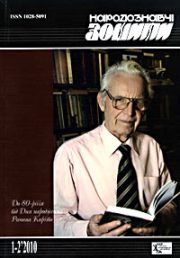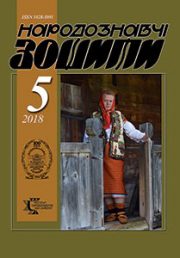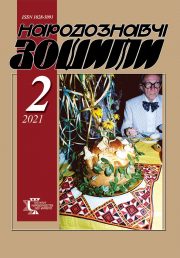The Ethnology Notebooks. 2022. № 1 (163), 105—112
UDK 75.071.1-055.2:061.2Паркомуна(477-25)”199″
DOI https://doi.org/10.15407/nz2022.01.105
THE CREATIVE INTENTIONS OF WOMEN ARTISTS OF THE SQUAT PARCOMMUNE OF THE 1990s
LUTSYSHYNA Dariia
- ORCID ID: https://orcid.org/0000-0003-1048-6190
- Postgraduate,
- National Academy of Visual Arts and Architecture,
- 20, Voznesensky Descent, 04053, Kyiv, Ukraine,
- Contacts: e-mail: innuendo19@gmail.com
Abstract. Problem Statement. During the difficult transition period of instability and uncertainty in Ukraine in the late 1980s and early 1990s the squat on Paris Commune Street in Kyiv became one of the prominent art centers. The creative achievements of this community of young artists are usually represented by male names, since in general Parcommune existed outside the feminist context, but women artists and their creative work were an integral part of it and call for further research.
The purpose of the research is to define the creative intentions of the women artists of Parcommune, describe the peculiarities of their art activities and creative experiments within the squat considerig both female art practices and notable collaborations with male artists.
The object of research is the art of women artists of the squat Parcommune of the 1990s; their creative intentions are the subject of research.
The methods of research are the iconographic and iconological analysis, formal analysis, historical reconstruction, feminist method.
Results. The article outlines the historical context in which the art practices of women artists who lived and worked in the squat or belonged to its community developed. The article provides analysis of the work of artists, such as painting, video art, installation, sculpture. The research presents the topics that female artists purposefully or intuitively developed in their practice of that period, including the problems of philosophy and religion, feminism, gender, corporality, sexuality, violence, the role of women in art and society, etc. Solely female art practices are mentioned as well as some notable collaborations with male artists. In addition, the article pays attention to the curatorial projects of N. Filonenko within the squat, namely her project «Meduza’s Mouth», which is also considered the first Ukrainian feminist exhibition. It is emphasized that the members of the community sought the topics for their art work outside the socio-political field, and those issues of feminism that drew attention of women artists often remained not fully reflected and elaborated. However, the art practices of female artists of Parcommune are a notable phenomenon in the art of the 1990s, and their further study is essential for better understanding of Ukrainian contemporary art.
Keywords: Squat Parcommune, women artists, feminist exhibition, feminist art, painting, video art, installation, sculpture.
Received 19.01.2022
REFERENCES
- Solov’ev, A. (2000). The art of Ukraine of the 90s. Moscow Art Magazine, 28—29. Retrieved from: http://moscowartmagazine.com/issue/79/article/1726 (Last accessed: October 1, 2021) [in Russian].
- Bredihina, L. (2005). The Eve’s rib, Adam’s shoulder and more. Dialogue of Arts, 2, 78—82 [in Russian].
- (2018, march 20). Lecture «Ukrainian media art of the 90’s: the gender aspect». (Video). YouTube. Retrieved from: https://www.youtube.com/watch?v=xR-I_5nOqXc [in Ukrainian].
- Platonova, A. (2018, march 23). Flashback from the 90s: 10 key works of Ukrainian media art of that time. LB. Ua. Retrieved from: https://lb.ua/culture/2018/03/22/393287_fleshbek_90h_10_klyuchevih_rabot.html (Last accessed: July 7, 2021) [in Ukrainian].
- Kochubinska, T., & Pinchuk Art Centre (Eds.). (2018). Parcommune. Place. Community. Phenomenon. Kyiv: Publish Pro [in Ukrainian].
- Yakovlenko, К. (2016, October 24). Valeryia Trubina: «We expanded the space, allowing the viewer to enter». Korydor. Retrieved from: http://www.korydor.in.ua/ua/voices/valeria-trubina-my-rasshiryali-prostranstvo-pozvoliaja-zriteliu-tuda-vojti.html (Last accessed: December 24, 2020) [in Russian].
- Yakovlenko, К. (2017, march 7). The «body» of the Paris Commune (Part one). Korydor. Retrieved from: http://www.korydor.in.ua/ua/context/telo-parizhskoj-kommuny-part-one.html (Last accessed: July 14, 2021) [in Russian].
- Yakovlenko, К. (2018, November 9). «Mouth of Medusa»: the first attempts at feminist exhibitions. Korydor. Retrieved from: http://www.korydor.in.ua/ua/context/rot-meduzy-pershi-sproby-feministichnyh-vistavok.html#_ftn4 (Last accessed: august 18, 2021) [in Ukrainian].
- (2011, September 23). Biruchiy contemporary art project. Curator’s lecture. Live broadcast from the project «Biryuchiy 018 or Neo-Shamanism. The Power of Ritual». [Video]. Facebook. Retrieved from: https://www.facebook.com/biruchiy.art/videos/244783072826150/ (Last accessed: june 23, 2021) [in Russian].
- Yakovlenko, К. (2020, November 26). The place of emancipation, sexuality and «the touch of feminism» in Ukrainian art of the 1990s. Support of our art. Retrieved from: https://supportyourart.com/specialprojects/researchplatform/1990-nbsp-cinema/ (Last accessed: july 23, 2021) [in Ukrainian].
- Lyapin, O. Oleksandr Lyapin about the Mouth of the Medusa exhibition. Research Platform Online Archive. Retrieved from: https://archive.pinchukartcentre.org/reviews/oleksandr-lyapin-pro-vistavku-rot-med (Last accessed: October 2, 2021) [in Ukrainian].
- Prudenko, Y. (2010, September 16). The games with a video camera. The first Ukrainian video art. Artvertep. Retrieved from: http://artvertep.com/news/12399.html (Last accessed: October 25, 2020) [in Ukrainian].
- Distorting mirrors — live pictures. Open Archive of Ukrainian Media Art. Retrieved from: http://www.mediaartarchive.org.ua/media-art/krivi-dzerkala-zhivi-kartini/ (Last accessed: October 5, 2021) [in Ukrainian].






